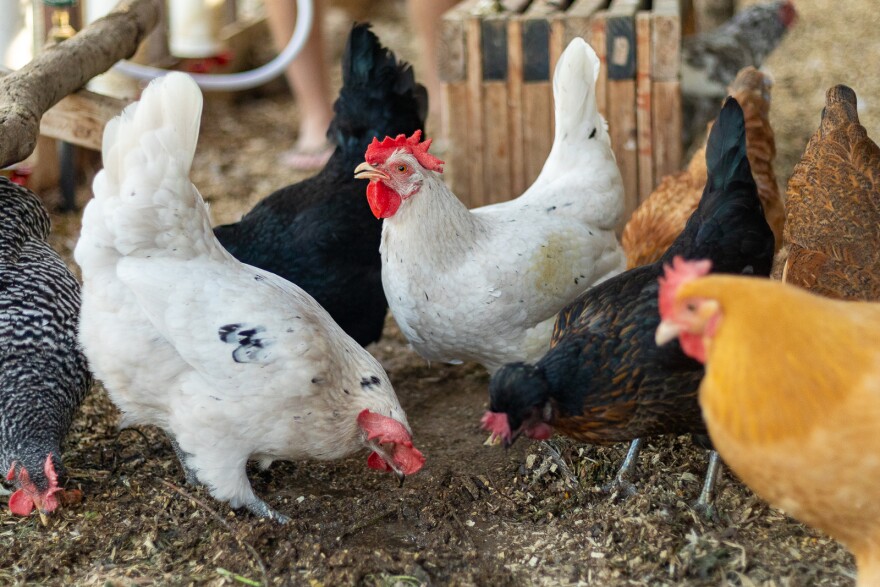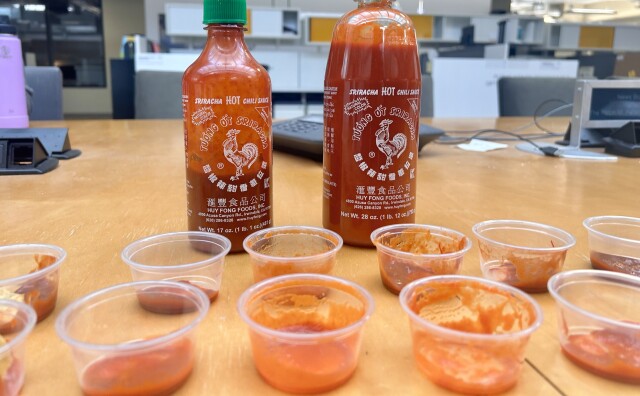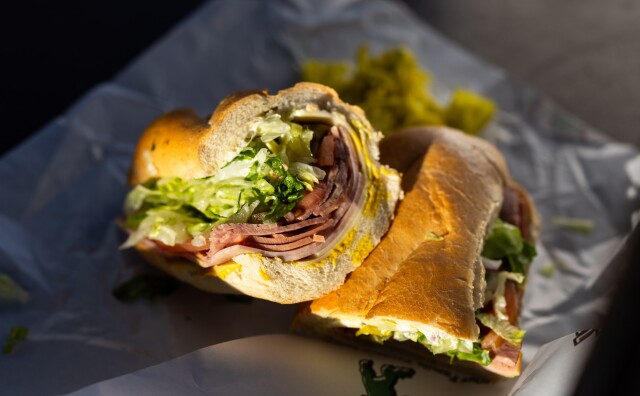Rising Egg Prices Are For The Birds. Maybe It’s Time To Raise Backyard Chickens

Soaring egg prices. Completely empty shelves at Costco. Rationing your use of eggs in cooking. The deadliest outbreak of bird flu on record wiped out more than 50 million poultry birds and made us all rethink our devil-may-care reliance on a continuous supply of eggs.
It will take at least several months for egg prices to stabilize. So is this moment you finally go hyper-local, and invest in a small flock of chickens for your backyard?
Um, maybe not. Thinking about doing something only when you need to is kind of the opposite of how raising a flock of chickens works. You need to think about these living creatures more often than when they have something you can use. You have to make sure they have enough food, enough water, and aren’t overheating or pecking at the smallest member of the flock.
So is it worth that to save on egg-sessive stress? If you’re still interested — and excited at the prospect of getting the freshest and tastiest possible eggs — read on.
-
Now in effect in the city of L.A.
-
Ideas for putting those pesky piles to good use
-
"Mission-to-Mission" event along 5.5 miles of road
I wanted to find out what really goes into rearing chickens from people who are doing it. So I spoke to Offer Grinwald, who’s been raising chickens in his backyard in the West San Fernando Valley for about four years. He’s had ups and downs, but currently, his flock is healthy and producing seven to eight eggs daily.
I also discussed all things chicken with Natalie McCall, on the other side of L.A. County, who has been raising chickens in the “kinda farm-ish” hills of West Covina, after she and her boyfriend moved there from downtown during the pandemic.

The house that they bought happened to have a chicken coop. She says "instead of really thinking it through,” her boyfriend bought five chickens that “came in a grocery box." They quickly learned how to keep them alive. McCall says she hasn’t bought eggs since 2021.
I asked them both for some pointers for newbies to the chicken game.
Persuading your family
“The first thing that you need to do when you’re considering having chickens is convincing the people that you live with that it’s a good idea,” Grinwald said.
It took him almost “three to four years of being really annoying, non-stop talking about chickens,” he added. Eventually, his wife and daughters came around.

Cheaper than buying eggs?
For McCall, "it's not cost effective, because every bag of grain is $15.” Her eight chickens eat three-quarters of a bag a week. But she says, the benefits outweigh the cost. "These are the greatest eggs I’ve ever had.”

Having the space
Grinwald says that if you’re raising regular-sized chickens in a coop, you’re going to need between three to five square feet of coop space per bird, as long as they have space to roost at night and they’re able to go outside during the day.
Another option is to have them walking around in your backyard where they’ll eat plants and forage for food, but Grinwald says “there’s gonna be a lot of poop all over the ground if you let them be free range.”
Buying a coop
The chickens need somewhere safe to stay at night. So you’re going to need a coop. You want them to be protected from local predators like hawks, rodents, raccoons, skunks, opossums and coyotes.
You can buy fancy designer coops for a few thousands dollars or you can build one yourself, but Grinwald says any coop will do as long as there are bars inside the enclosure for chickens to sleep on. This is a roost, so it basically emulates tree branches for them to hold on to.
-
- The “Flock Talk” column on the Hobby Farms website is regularly updated with tips.
- Kathy Shea Mormino’s The Chicken Chick website and Facebook page are some good resources.
- The Happy Chicken Coop website has some helpful step-by-step guides.
- The “Flock Talk” column on the Hobby Farms website is regularly updated with tips.
The chickens also need a place to lay their eggs — a nest box. They don’t automatically know where they are supposed to nest, so you have to show them. It can take a few weeks but they’ll figure it out.
McCall says she's had some tragedy — opossums killed a pair of her Silkie chickens. "After that incident, we went and got an even smaller closure,” she says. They still let them out in the chicken run, but they have it fenced in and make sure to close them in at sunset. They haven't had critter problems since.

Choose a breed of chicken
Different types of breeds have different characteristics.
Rhode Island Red, for example, produce a good amount of eggs but are said to be super aggressive. Plymouth Rocks, on the other hand, produce a decent amount of eggs and are known for being docile.
McCall says her hens, from different breeds, have never laid a white egg. Henrietta is an Ameraucana, whose eggs are speckled green and blue.
Wanda is a Rhode Island Red, who lays brown eggs.
And Monica — well, McCall is not exactly sure what breed Monica is, but she is very docile, and lays pinkish white eggs.

Decide how many chickens
You’re gonna need more than one chicken in your flock. They’re social animals and they need their best friends around. Grinwald started with seven, but says a minimum number of chickens is two.
You also have to keep in mind that there will be a “pecking order” — where the older and bigger hens push to eat first, and they’ll start pecking at the littler ones until all they fall in line. “Not all chickens get along,” says Grinwald. “If it’s a small enough chick another chicken may injure it or kill it.”
McCall says they understood the pecking order was real when one of their birds was ostracized by the others. They named her “chicken little” and penned her off separately to protect her. But soon they realized that “she” was in fact a male rooster, who’d been hard to differentiate at the beginning because he didn’t have plumage. Eventually his feathers grew in “great color patterns,” she says.

Chicks vs. Rooster
Grinwald says “in theory you could buy a recently hatched chick from a feed store for six bucks, but you’re going to have to wait several months for it to grow while you take special care of it.” Then you have to introduce it to the flock, which could bring its own problems. “But that $6 bird could deliver you a lot of eggs over time.”
Some people also choose to raise a rooster to fertilize eggs — but according to Grinwald “having a rooster is its own disaster. It’s a little loud and they get cocky, and in some communities they’re illegal.”
Places like Beverly Hills and Cerritos have outright backyard chicken bans. In Santa Monica you can have up to 13 chickens, including roosters, but a permit is required, while in the city of Lakewood, you can have five chickens but no roosters.
In the City of Los Angeles the number of chickens (and roosters) is determined based on your zone. Check to see the restrictions in your area.
Weatherproofing your flock
Chickens can live in cold conditions — in some places they’re raised in the snow.
The more common problem we face here in L.A. is overheating. The West Valley can get to 110 degrees in the summer, “so you need to go in a few times a day, water down the area, and spray the bird,” says Grinwald.
Dealing with chicken poop
There are a few approaches to dealing with chicken waste. Grinwald practices what chicken farmers call “deep litter.” According to The Chicken Chick blog, it’s “a method of chicken waste management that calls for droppings and bedding material to compost inside the chicken coop, instead of being cleaned out and replaced regularly”
Grinwald puts pine shavings and straw on the floor of the coop. “It makes it comfortable, and the dry shavings dry out the poop and neutralizes the ammonia, so it doesn’t really smell, even with 14 chickens,” he says.
The flock will also forage from what they find beneath the litter. Flies lay their eggs in the shavings which grow into larva, and are quickly eaten by the birds.
Grinwald’s family also composts all their kitchen scraps, throwing them straight into the litter. Grinwald says the “right ratio for a good situation is one-third compost, one third grains and one-third greens.”

This process leads to healthy, happy chickens, says Grinwald. “Their food and poop creates a microbiome community, and that improves their gut health. If you’re eating the eggs, it helps your gut health too.”
Each year, Grinwald harvests a few inches from the bottom of their coop and throws it into his garden. “The chickens eat the compost, and their poop becomes fertilizer, and it helps everything — it’s a circle of life,” he says.
Count your eggs
Yes, that's right, before they hatch. Grinwald says his flock will lay about seven to nine eggs a day in the summer, although production goes down in the winter while they’re rebuilding their protein.
That cycle will slow as the bird ages. “If a chicken's lifespan is five years," Grinwald says, "at eight months they’re going to start producing a ton of eggs, maybe five times a week per chicken — but as they get older, maybe they’re going to produce one egg a week.”

Storing fresh eggs
Eggs laid fresh from a hen should be treated differently to factory farmed eggs.
“We never stick eggs in the fridge,” says McCall. “We keep eggs on the counter for two weeks at a time."
Grinwald says factory farmed eggs need to be refrigerated because the natural protective ‘bloom’ coating has been washed off before it gets to the store. This is because factory farming can lead to unsanitary conditions, so federal law requires that the gunk is removed — along with the bloom.
“If you imagine in the wild — the egg is supposed to last at least three weeks as the hen sits on it, waiting for chicks to hatch,” Grinwald says.
-
After people began complaining online that Sriracha they'd bought recently didn't taste like the old stuff, we set out to find the answer. It didn't go well.
-
From tortas to tuna melts, all sandwiches tell a unique story as they celebrate Los Angeles' diverse tapestry of flavors with each bite.
-
The company behind Sriracha told us production has resumed.
-
Dustin Bartz has figured out a way to sell a $6 smashburger — and still make a tidy profit. He enjoys trolling competitors who charge more.
-
Two amateur bakers take on a beloved, almost sacrosanct school treasure.
-
For Jeff Alulis, the Burger Quest became “something bigger” than him.









